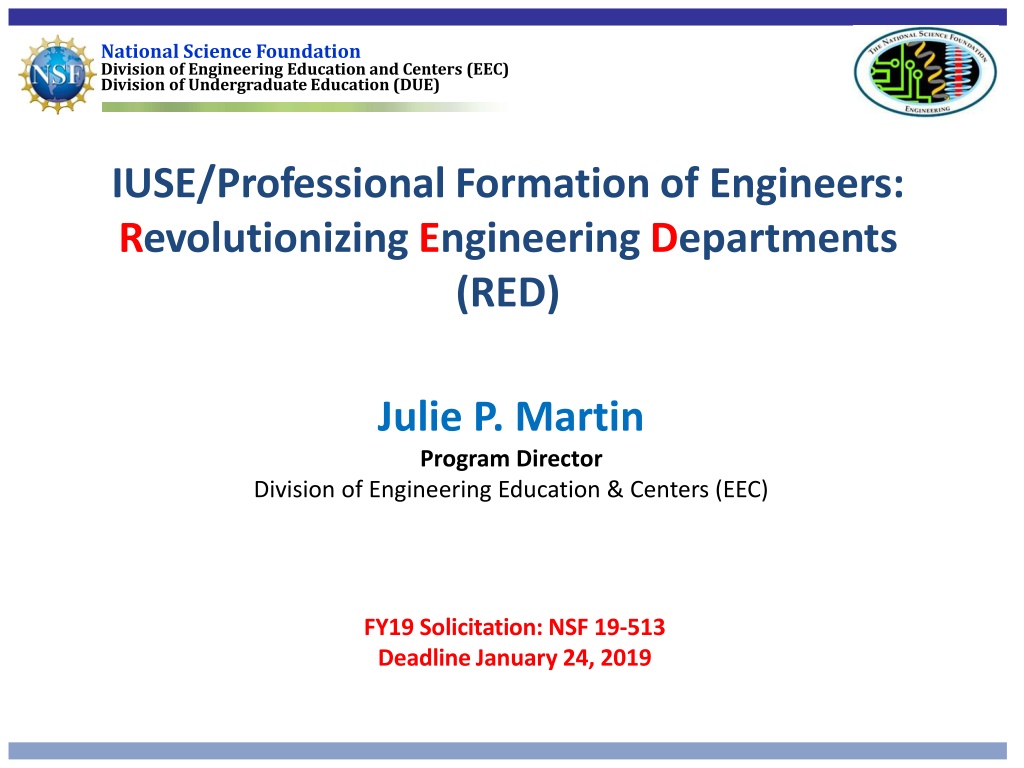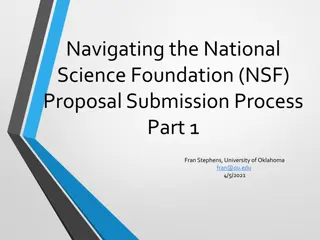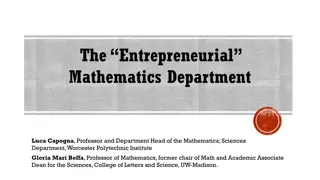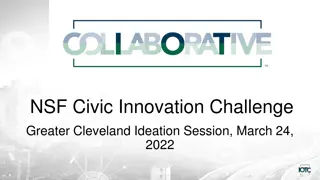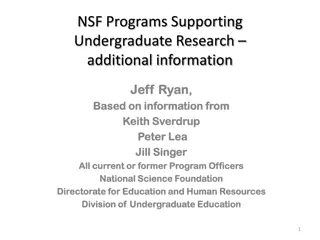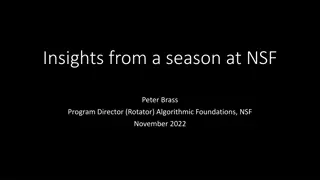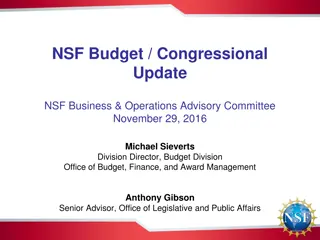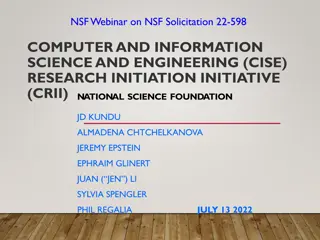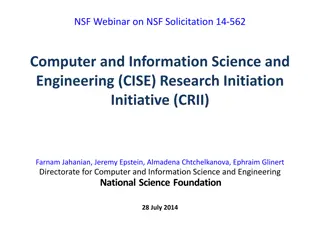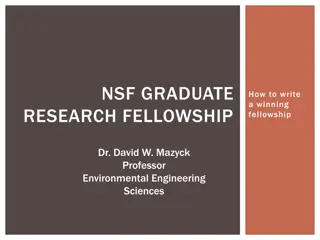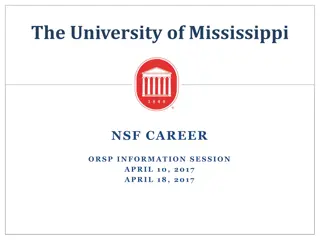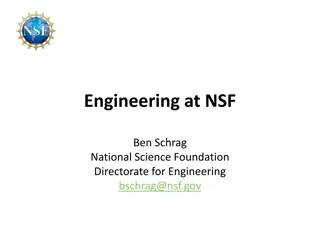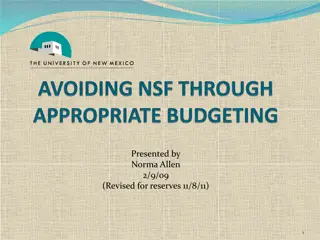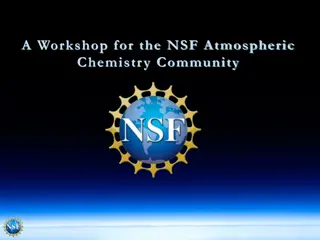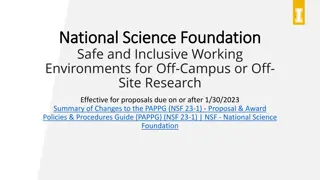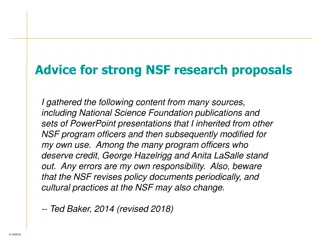Revolutionizing Engineering Departments: NSF's RED Initiative
NSF's Division of Engineering Education and Centers (EEC) aims to revolutionize engineering education by focusing on the middle two years of undergraduate curricula. The RED initiative emphasizes revolutionary changes in engineering departments to address complex 21st-century societal challenges. The program seeks to support cultural, organizational, and pedagogical shifts through faculty engagement and leadership, aiming for fundamental structural overhauls in engineering education.
Download Presentation

Please find below an Image/Link to download the presentation.
The content on the website is provided AS IS for your information and personal use only. It may not be sold, licensed, or shared on other websites without obtaining consent from the author. Download presentation by click this link. If you encounter any issues during the download, it is possible that the publisher has removed the file from their server.
E N D
Presentation Transcript
National Science Foundation Division of Engineering Education and Centers (EEC) Division of Undergraduate Education (DUE) IUSE/Professional Formationof Engineers: Revolutionizing Engineering Departments (RED) Julie P. Martin Program Director Division of Engineering Education & Centers (EEC) FY19 Solicitation: NSF 19-513 Deadline January 24, 2019
National Science Foundation Division of Engineering Education and Centers (EEC) Division of Undergraduate Education (DUE) Prior NSF investments have significantly improved the first year of engineering students' experiences, senior capstone, yet gaps in ideal senior year Complex problems facing society in the 21st Century demand changes to the way engineers are educated Need to focus on the middle two years of undergraduate engineering curricula
National Science Foundation Division of Engineering Education and Centers (EEC) Division of Undergraduate Education (DUE) Focus on Revolutionary Revolutionary Change radically, suddenly, or completely new; producing fundamental, structural change; or going outside of or beyond existing norms and principles
National Science Foundation Division of Engineering Education and Centers (EEC) Division of Undergraduate Education (DUE) How Can We Support Revolutionary Change? Emphasis on cultural, organizational, structural and pedagogical changes , involving students, faculty, staff, and industry in rethinking what it means to provide an engineering program. Engineering departments: Department head leadership is potential lever for change NOT curricular reform! Faculty engagement essential to organizational change: Faculty development Faculty reward systems Cultures that support faculty engagement
National Science Foundation Division of Engineering Education and Centers (EEC) Division of Undergraduate Education (DUE) RED Teams Organizational Change Expert PI Dept. Chair/Dean Eng. Ed. Researcher
National Science Foundation Division of Engineering Education and Centers (EEC) Division of Undergraduate Education (DUE) Funded Projects FY2015-2017: ENG+EHR+CISE funded 19 Revolutionizing Engineering & Computer Science Departments The 19 RED programs are changing department culture and contributing to literature and contributing to the literature on organizational change
National Science Foundation Division of Engineering Education and Centers (EEC) Division of Undergraduate Education (DUE) RED Impact Departments are becoming change exemplars New organizational models in departments Fundamental shifts in approaches to course content and the way they are offered Meaningful collaborations between education and industry New models for supporting underrepresented students
National Science Foundation Division of Engineering Education and Centers (EEC) Division of Undergraduate Education (DUE) RED Impact: Markers of Change Change doesn t start with the syllabus, change shows up the syllabus Engagement of department heads and deans Resource allocation Language in position descriptions & hiring letters P&T policies revolutionary ideas are not tack-ons
National Science Foundation Division of Engineering Education and Centers (EEC) Division of Undergraduate Education (DUE) RED Participatory Action Research Rose-Hulman & University of Washington Studying the change agents themselves to understand how to create diffusion of new ideas Foster and support cohort /collective impact ethos
National Science Foundation Division of Engineering Education and Centers (EEC) Division of Undergraduate Education (DUE)
National Science Foundation Division of Engineering Education and Centers (EEC) Division of Undergraduate Education (DUE) FY 19 Solicitation: Major Changes An Adaptation & Implementation (A&I) track was added to foster the propagation of proven change strategies to new contexts. Computer Science is no longer included.
National Science Foundation Division of Engineering Education and Centers (EEC) Division of Undergraduate Education (DUE) IUSE/PFE: RED Two Program Tracks Innovation Adaptation & Implementation Evidence-based and evidence- generating change strategy approaches and actions adapted to the local context Radically, suddenly, or completely new approaches and actions Producing fundamental, structural change Go outside of or beyond existing norms and principles Maximum $1M Up to 5 yrs Between $1M to $2M Up to 5 yrs Both tracks include consideration of cultural, organizational, structural, pedagogical changes needed to transform the department to one in which students are engaged, develop their technical and professional skills, and establish identities as professional engineers. Proposals outside the budgetary limits will be returned without review
National Science Foundation Division of Engineering Education and Centers (EEC) Division of Undergraduate Education (DUE) Outcomes for Both Tracks Fund programs that can serve as exemplars of change Revolutionary change to middle two years of undergraduate curriculum Connect engineering education research and practice Contribute to the literature on change Create of a cohort of project teams with activities and collaboration within and across cohorts
National Science Foundation Division of Engineering Education and Centers (EEC) Division of Undergraduate Education (DUE) Vision for Department Describe the department and the student professional formation experience after the revolution. How is success defined? Provide a concise answer to the question: What will be different?
National Science Foundation Division of Engineering Education and Centers (EEC) Division of Undergraduate Education (DUE)
National Science Foundation Division of Engineering Education and Centers (EEC) Division of Undergraduate Education (DUE) Successful RED Proposals Vision: How revolutionary is the vision in light of a well-grounded understanding of the history, context, and culture of the department? PI Team: Is the RED team complete, with all required expertise? Is each member fully qualified to perform the proposed work? Institutional Commitment: Do the letter(s) of commitment provide evidence of support for the project sufficient to achieve the goals and objectives? Connection to Professional Practice: Is there a sufficient connection in the proposed project to professional practice? Faculty Development Plan: Is faculty development well planned and properly incentivized to build department cultures that support the holistic professional formation of engineers?
National Science Foundation Division of Engineering Education and Centers (EEC) Division of Undergraduate Education (DUE) Successful RED Proposals Potentialfor Success and Scalability:How achievableandsignificantare the proposedchangesin the middletwo yearsof the technical core? How responsive are the changes to the call to focus on professionalskills? Reviewers will take into account justification of the research plan using the literature, comprehensiveness of the plan, institutional leadership commitments, sustainability of change (including leadership changes and financial sustainability) RED Innovation: Is the theory of changevalid and well-justified? How well- justified are the propagation roadmap/transferability of change strategies? RED A&I: How reasonable and appropriate is the reach of the dissemination plan? Connectionto Research on Engineering Education:How well-informed are the vision and execution plan by the literature and priorattempts,if applicable, to implement change?Is the expectation of success well- justified? Adaptation & Scaling: How likely is the new knowledge generated about how to change department culture to be received and utilized by others? How well-conceived are the plans for accomplishing these goals?
National Science Foundation Division of Engineering Education and Centers (EEC) Division of Undergraduate Education (DUE)
National Science Foundation Division of Engineering Education and Centers (EEC) Division of Undergraduate Education (DUE) FAQs How many proposals can be submitted by an institution? A maximum of proposals per institution are allowed. Does 2 proposals from each institution mean one for each track? It s up to your institution how you want to do this as long as no more than 2 proposals are submitted per institution. My institution has a RED project, can I submit a proposal? An institution that already has a RED award can submit a RED A&I proposal to the new solicitation. Institutions with existing RED awards may not submit a proposal to the RED Innovation track. Can computer science departments submit proposals? Computer Science departments are no longer eligible to submit proposals to the RED program. Can proposals be submitted from engineering technology departments? Yes! We encourage engineering technology departments with four year programs to submit to the RED program
National Science Foundation Division of Engineering Education and Centers (EEC) Division of Undergraduate Education (DUE) Reading List Webinar Developinga Competitive RED Proposalpresented by current RED awardees, https://academicchange.org/ Journalof EngineeringEducationSpecial Issue: The Complexities of Transforming EngineeringHigher Education,April 2014, 103(2):183-361. Johri, A. and Olds, B. (2014).CambridgeHandbookof Engineering EducationResearch.New York: Cambridge University Press. National Academy of Engineering.(2013).Educating Engineers:Preparing 21stCentury Leaderin the Context of NewModesof Learning.Washington, DC: National Academies Press. ASEE. Transforming Undergraduate Educationin Engineering:Phase I: Synthesizing and Integrating Industry Perspectives, May 9-10,2013. Workshop Report. http://www.asee.org/TUEE_PhaseI_WorkshopReport.pdf
National Science Foundation Division of Engineering Education and Centers (EEC) Division of Undergraduate Education (DUE) Q&A Type your question into the chat box
National Science Foundation Division of Engineering Education and Centers (EEC) Division of Undergraduate Education (DUE) Reading List Jamieson, L., and Lohman, J. (2012).Innovationwith Impact: Creatinga Culture for Scholarly and Systematic Innovationin EngineeringEducation. Washington,DC: American Society for EngineeringEducation. Watson, K. (2009).Changein EngineeringEducation:Where does Research Fit? Journal of EngineeringEducation,98(1): 3-4. Spalter-Roth, R., Fortenberry, N., and Lovitts, B. (2007).The Acceptance and Diffusion of Innovation:A Cross-Curricular Perspective on Instructional and Curricular Changein Engineering.Washington, DC: American Sociological Association and National Academy of Engineering Center for the Advancement of Scholarship in EngineeringEducation. National Academy of Engineering(2005).Educatingthe Engineerof 2020: AdaptingEngineeringEducationto the NewCentury. Washington,DC: National Academies Press.
National Science Foundation Division of Engineering Education and Centers (EEC) Division of Undergraduate Education (DUE) Project Plan and Evaluation Framework RED Innovation RED A&I Rationale & Context: Why change is needed in current department? How does context of original implementation compare to new context? How is original implementation being adapted to the new context? Goals & Objectives: What outcomes and targets at the end of this project will move the department toward the vision? What will change about the department? What will change about the faculty? What will change about the professional formation of students? Specific Actions: What is the evidence basis from the literature that supports use in the department s context? Specific Actions: How are activities being adapted for success in the new context? What is the theory of change; how and why should these activities effect lasting change? Barriers: What are anticipated barriers to achieving objectives? What contingency plans are in place?
National Science Foundation Division of Engineering Education and Centers (EEC) Division of Undergraduate Education (DUE) Project Plan and Evaluation Framework RED Innovation RED A&I Research Plan: What are your research questions? What educational or sociological theories inform them? What methods answer the research questions posed? These can be qualitative or quantitative as appropriate to the question and theoretical orientation. Evaluation Plan: Matches the scope of proposed work. Based on the theory of change and desirable outcomes of the proposed revolution. Evaluation Plan: Focuses on implementation of the proven strategies in the local context. What are the appropriate indicators of success related to accomplishing the goals and objectives and a timeframe to seek measurable change? Roadmap to Scaling & Adaptation: How will the project make an impact both locally and regionally/nationally by supporting revolutionary change in other departments? Dissemination Plan: How will knowledge from the adaptation be diffused to other departments and institutions?
